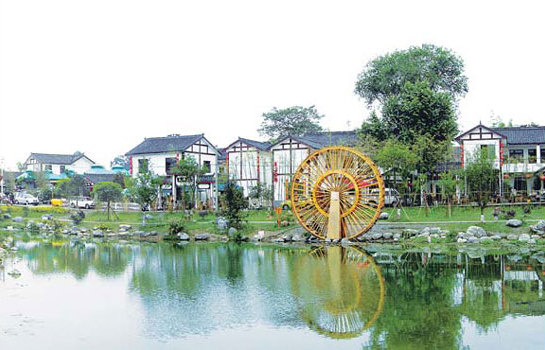

 |
| Pictured here is an aerial night view of Chengdu, a modern city rich in tourism resources. Photos provided to China Daily |
 |
|
Old-style homes line a quiet stream in a classic example of Chengdu's idyllic rural lifestyle. |
Visitors report high satisfaction as city improves services in this key industry
For the third consecutive year, Chengdu was among the top five in a national ranking of cities based on tourist satisfaction, according to an annual survey by the China Tourism Academy. Chengdu tourism strategy pays off.
The 2012 rankings, which were unveiled earlier this month, surveyed 60 domestic cities, and Chengdu ranked fifth after Suzhou, Shanghai, Huangshan and Nanjing. The city took fifth for the first time in 2010 and fourth in 2011.
The survey also rated Chengdu the highest among cities in the central and western region.
The local tourism authority estimated that the city received 122 million tourists over the last year, increasing 26.1 percent compared with 2011. More than 1.5 million of them were from overseas, up 27.7 percent year-on-year.
Last year, the tourism industry grew by 30 percent and generated 105 billion yuan ($17 billion).
The government of Chengdu is working to improve tourism management, policies and services to make the city into a world-renowned sightseeing destination.
Driving engine
Tourism strategies have been a focal point of the city's overall development plan since 2010, when it was named as one of the nation's first pilot cities for comprehensive tourism reforms.
The tourism authority has customized policies for each tourism site in the city in addition to establishing a promotional organization and a database of major projects.
The city government also has optimized land management policies related to tourism. In 2011, it unveiled new subsidies to major tourism projects and service infrastructure.
Tourism administrations have been established in 11 counties. Top city officials and county governments are involved in the management, including resources deployment, attracting investment and marketing strategies.
Longmen Mountain and Longquan Mountain have been designated as two pilot zones for ecological tourism-based industries.

In China, most giant pandas live in the mountains of Qinling, Minshan, Qionglai, Daxiangling and Xiaoxiangling.

By the end of 2011, the number of wild giant pandas in the world was about 1,590.